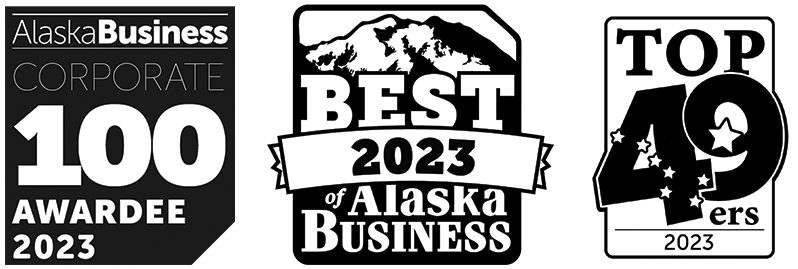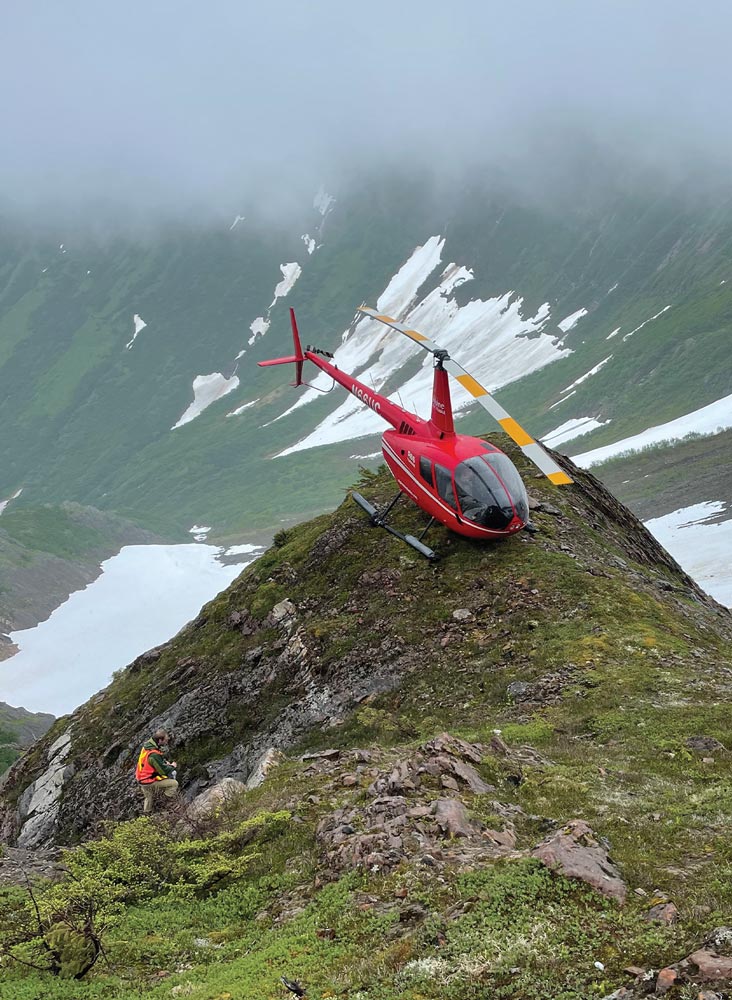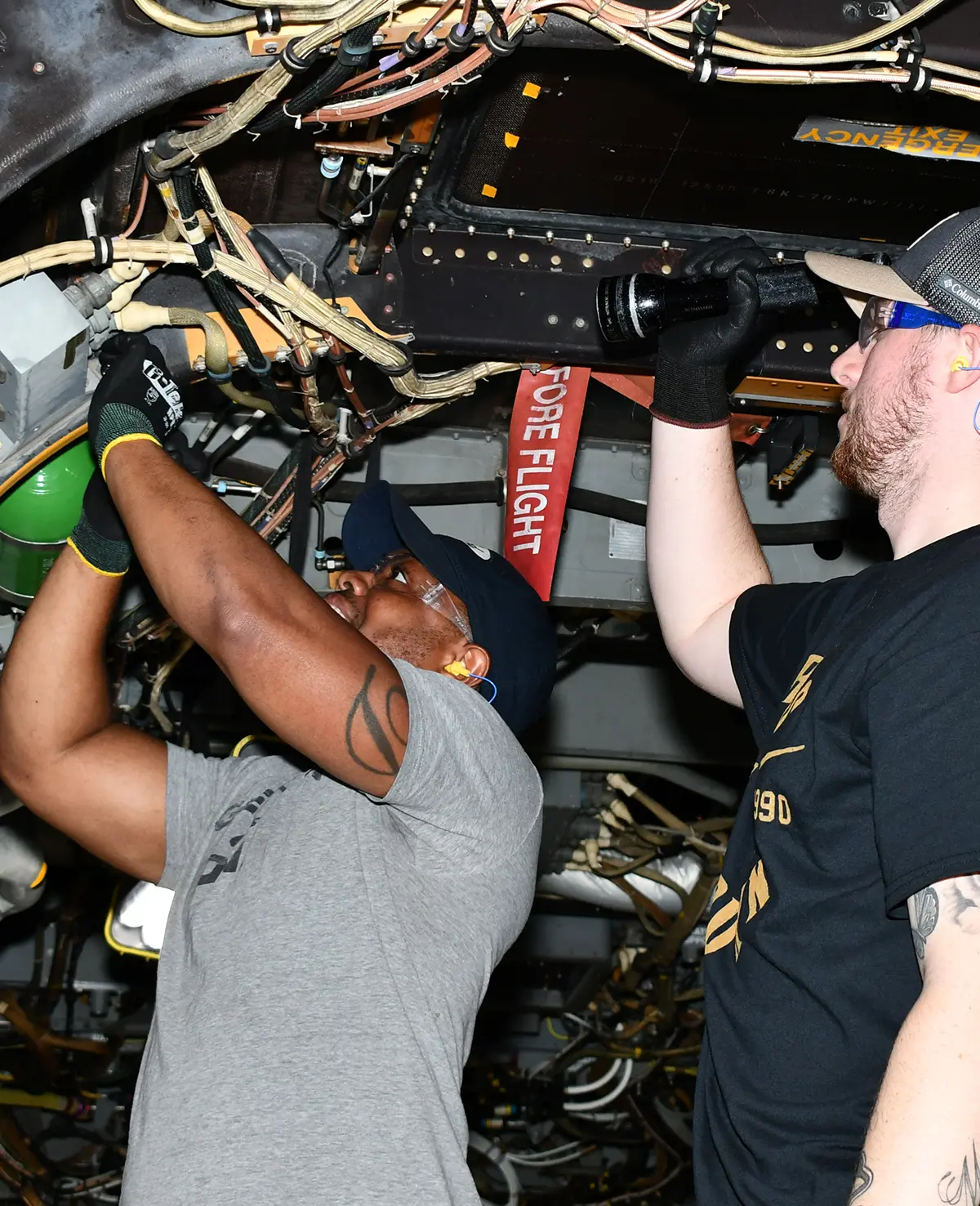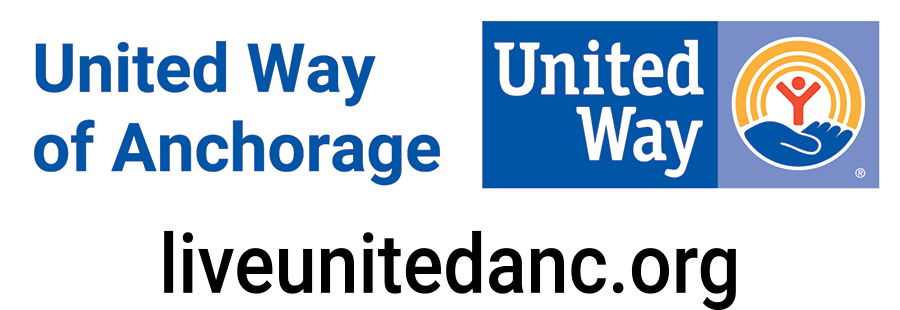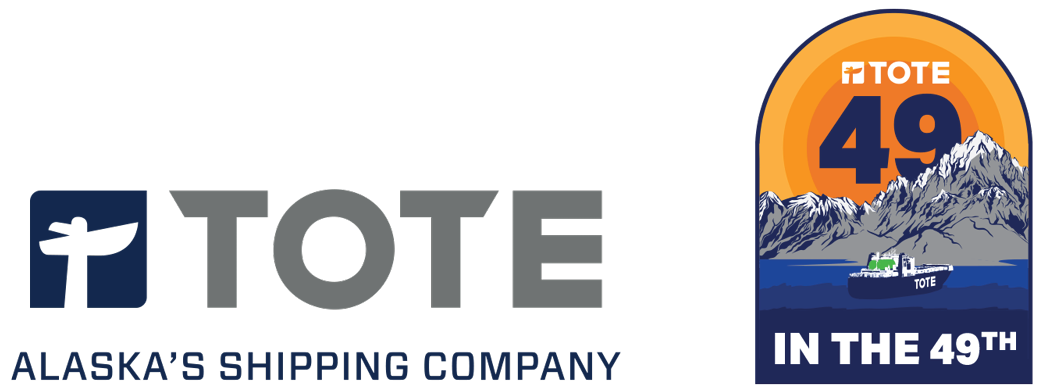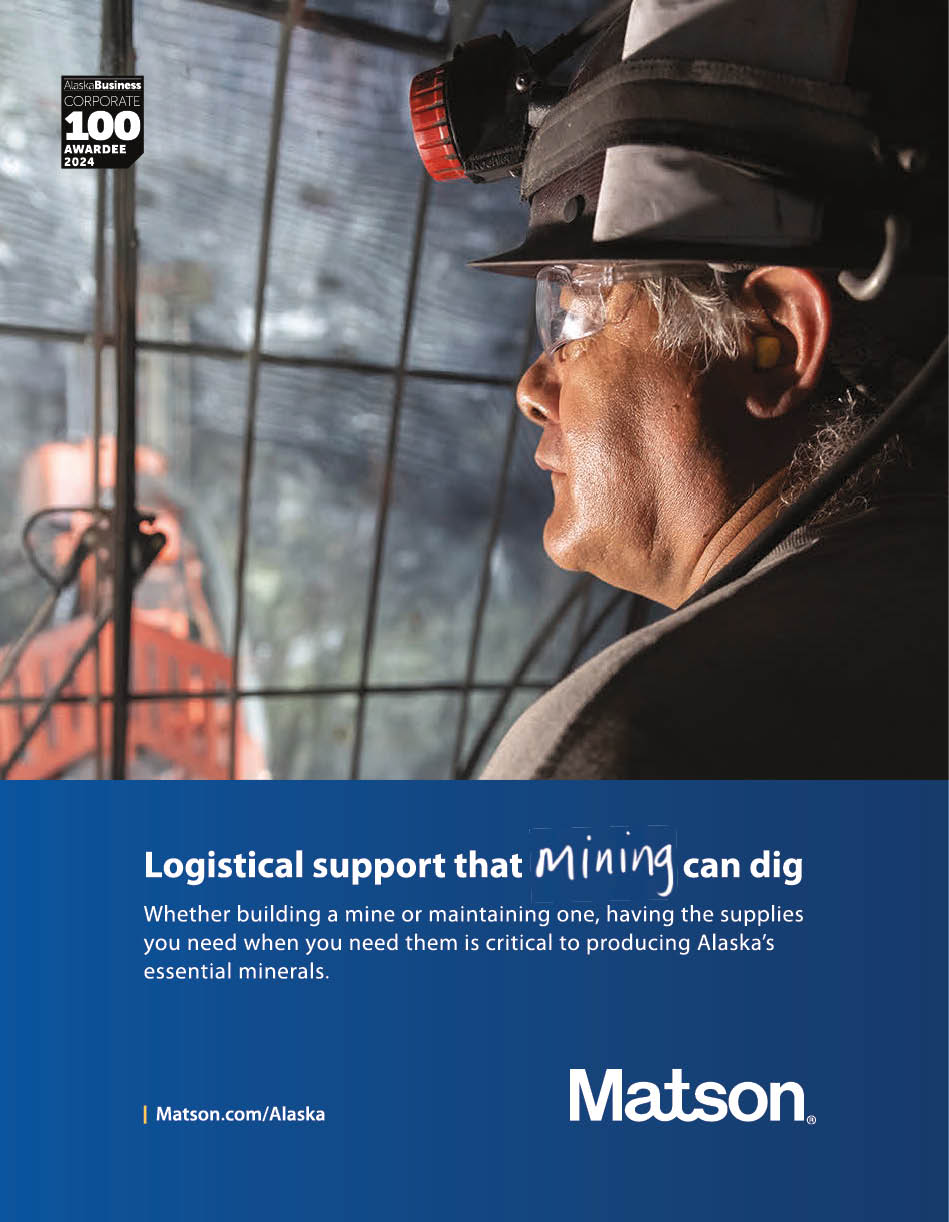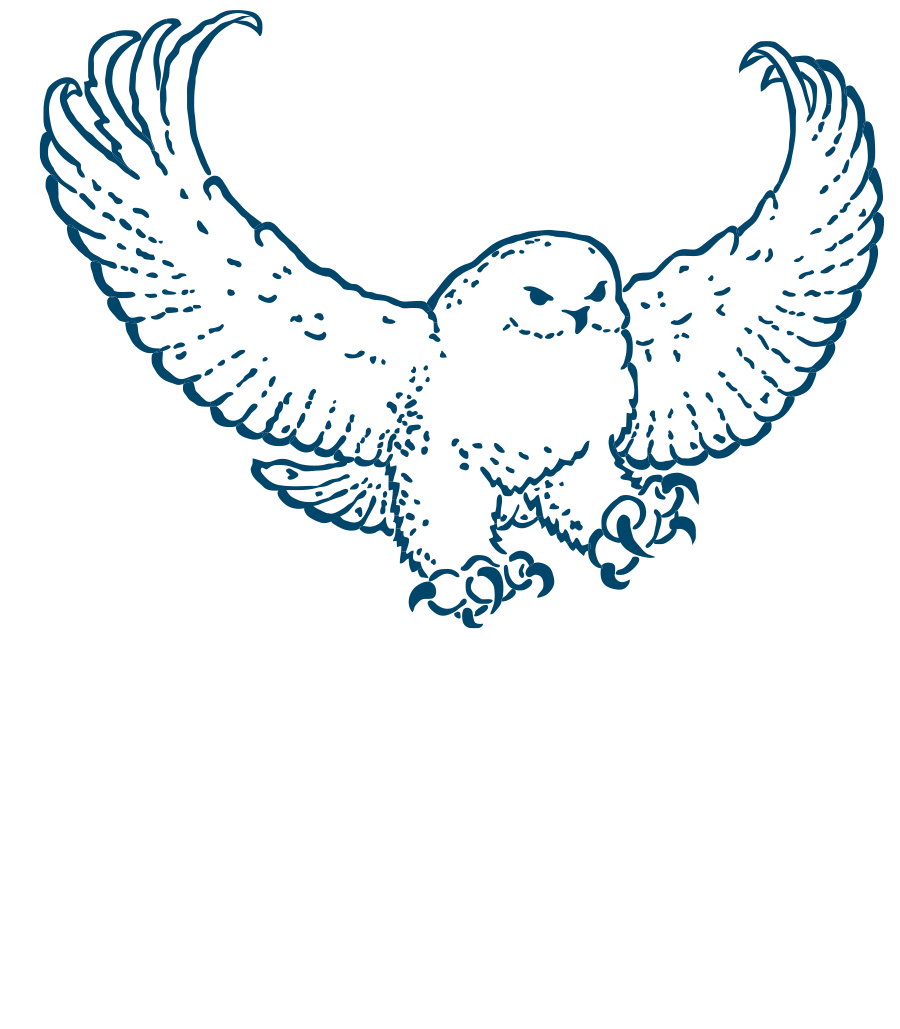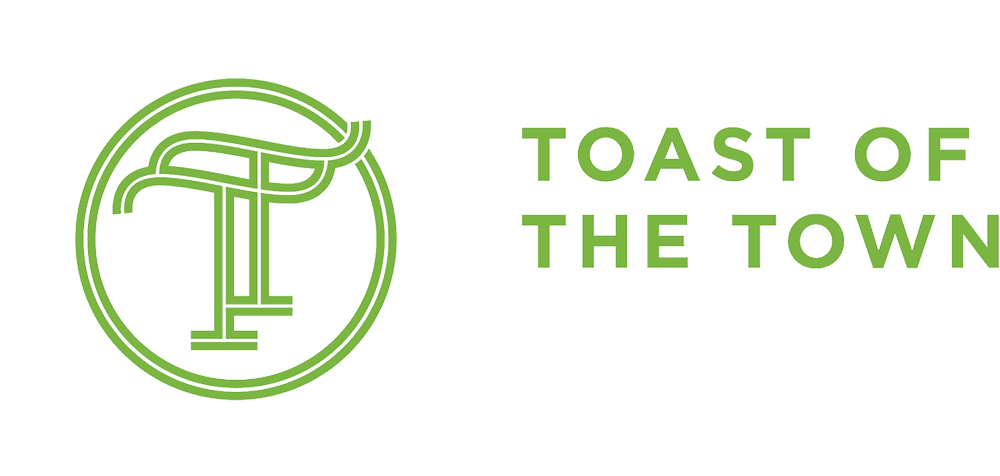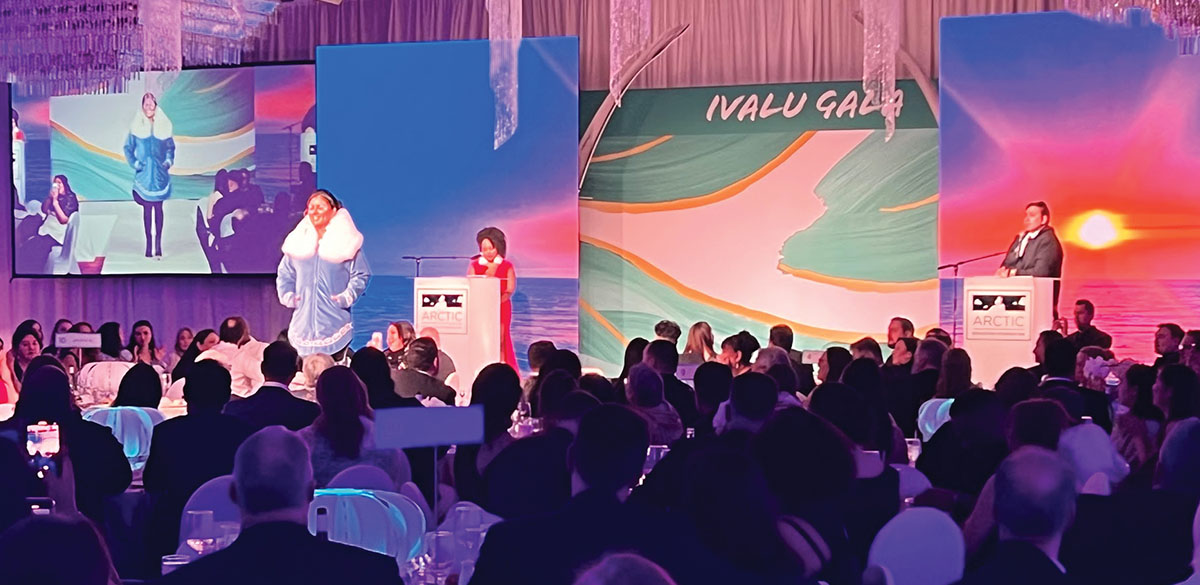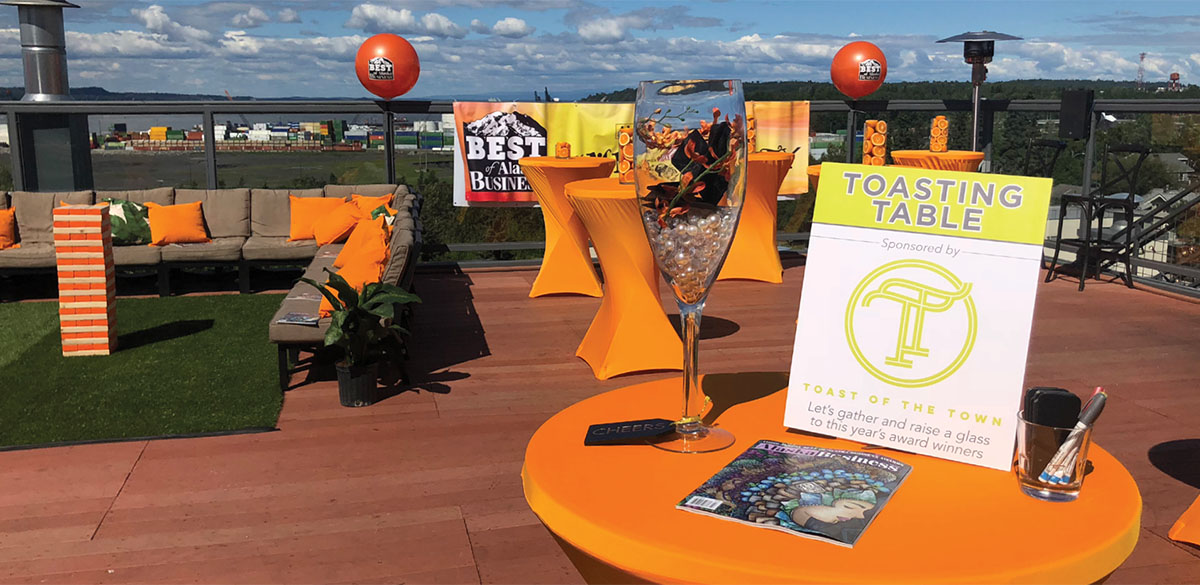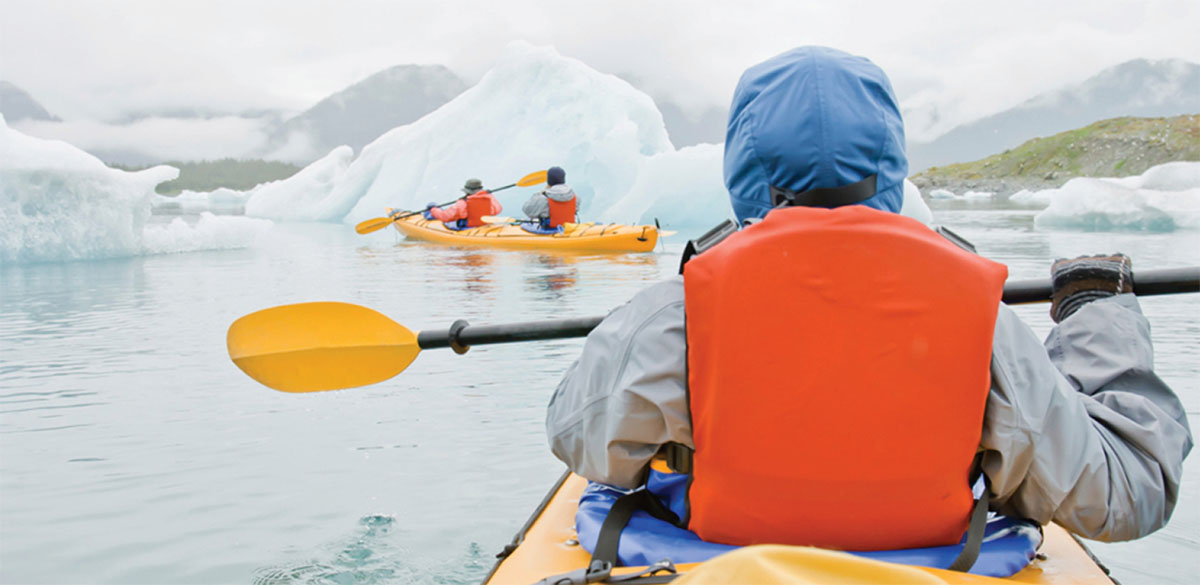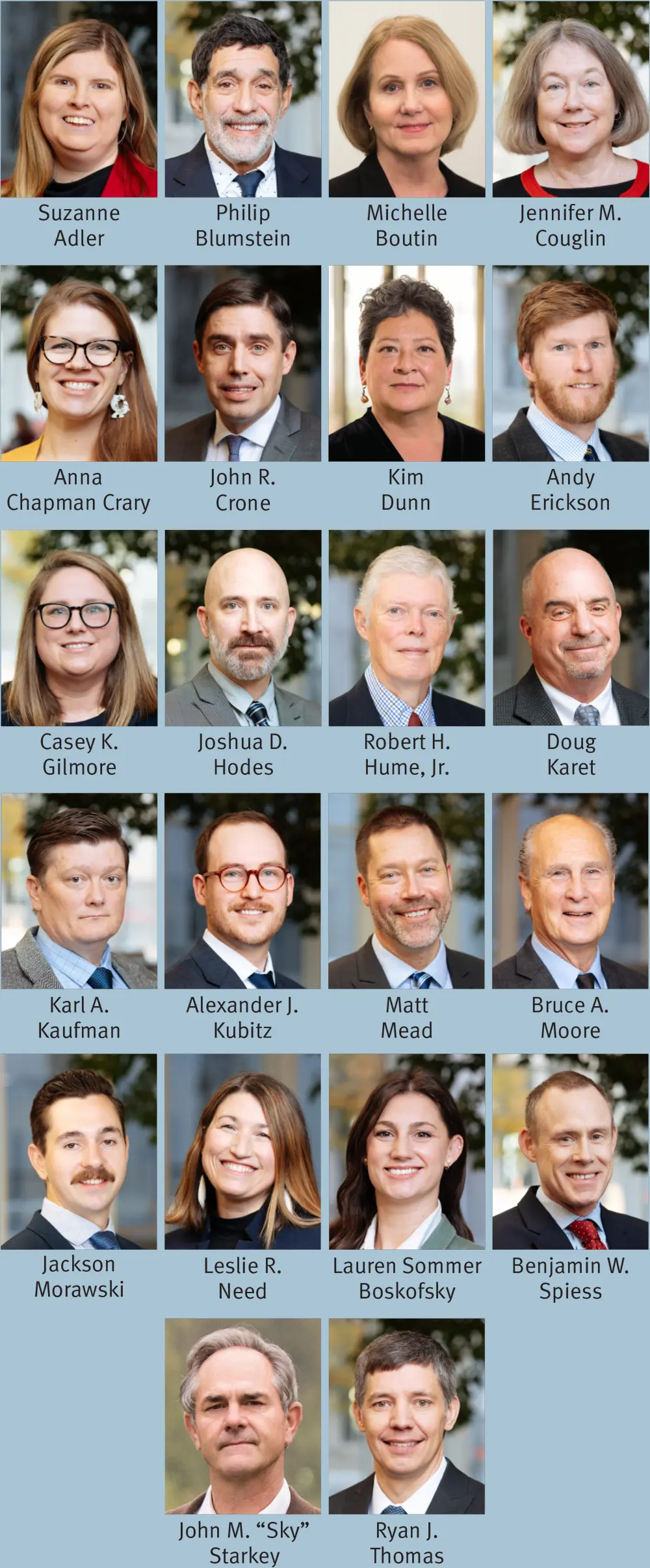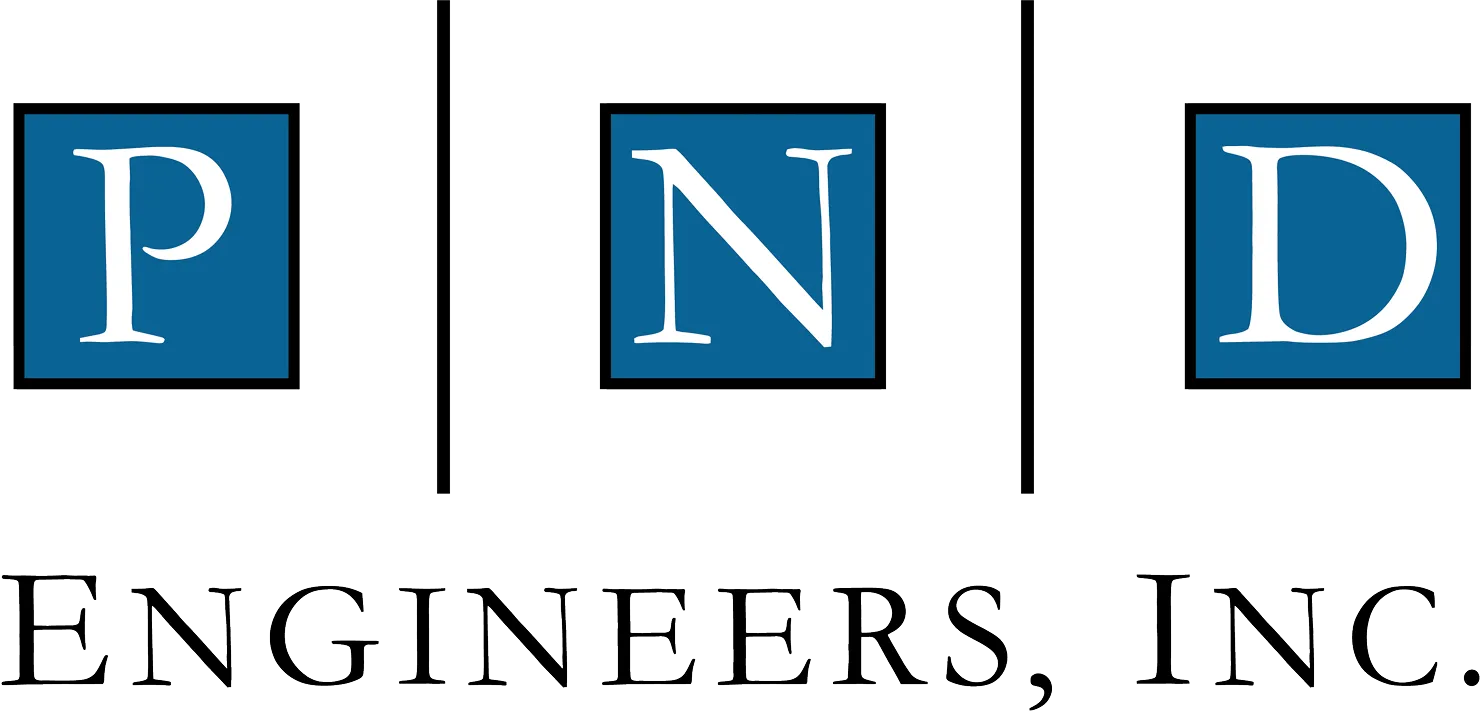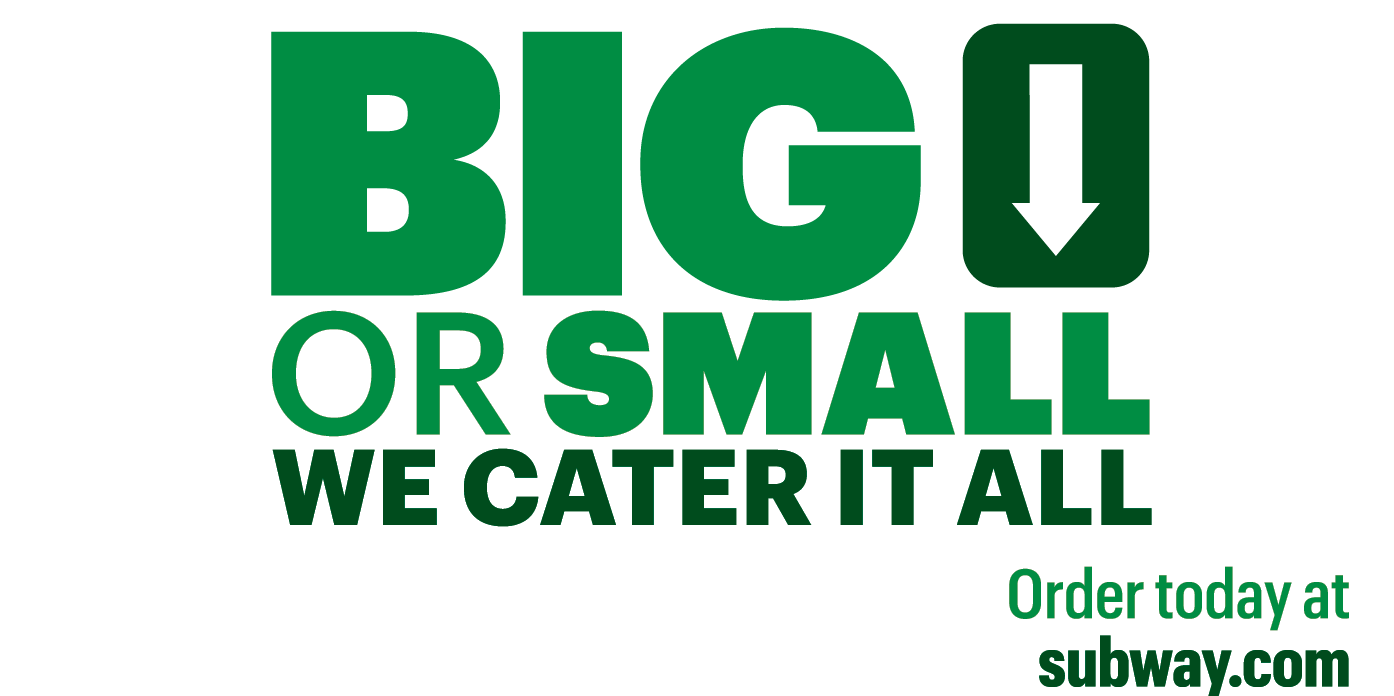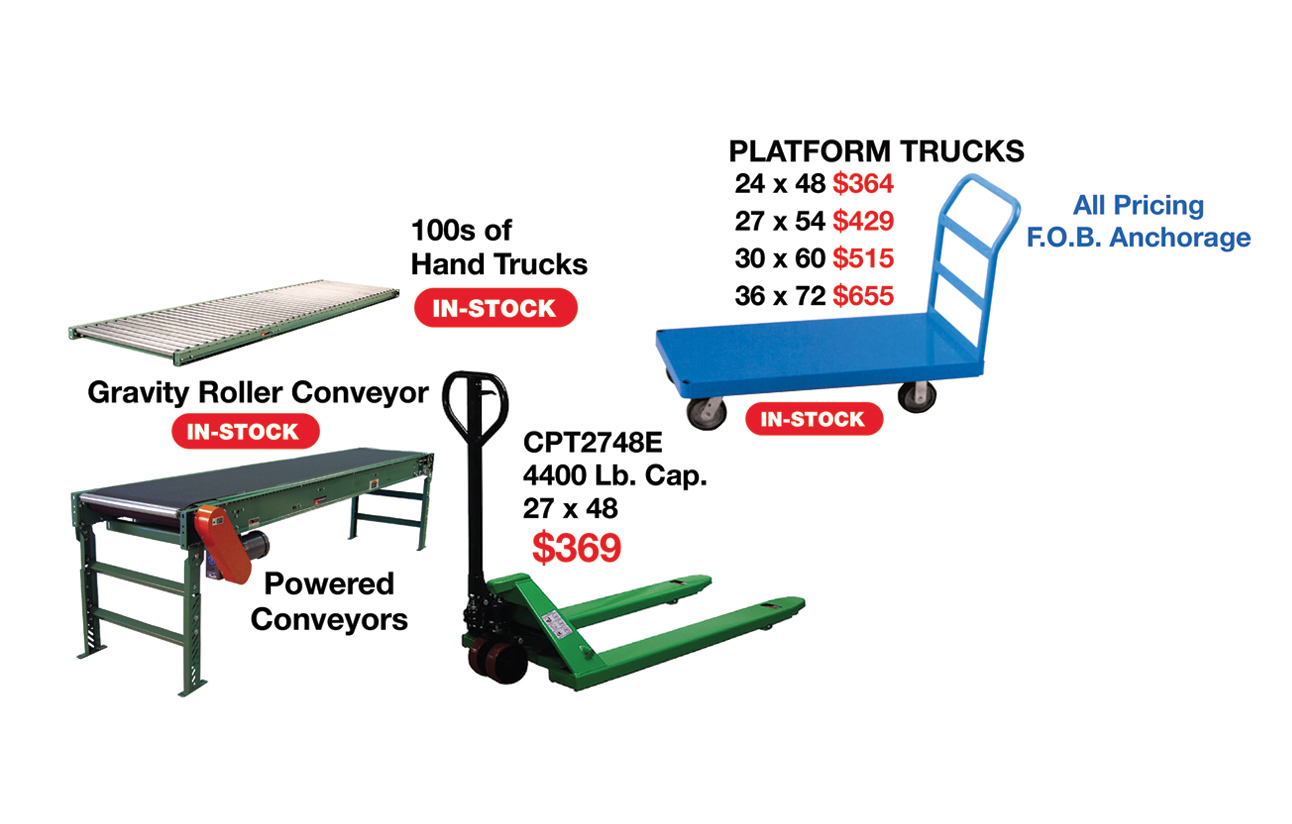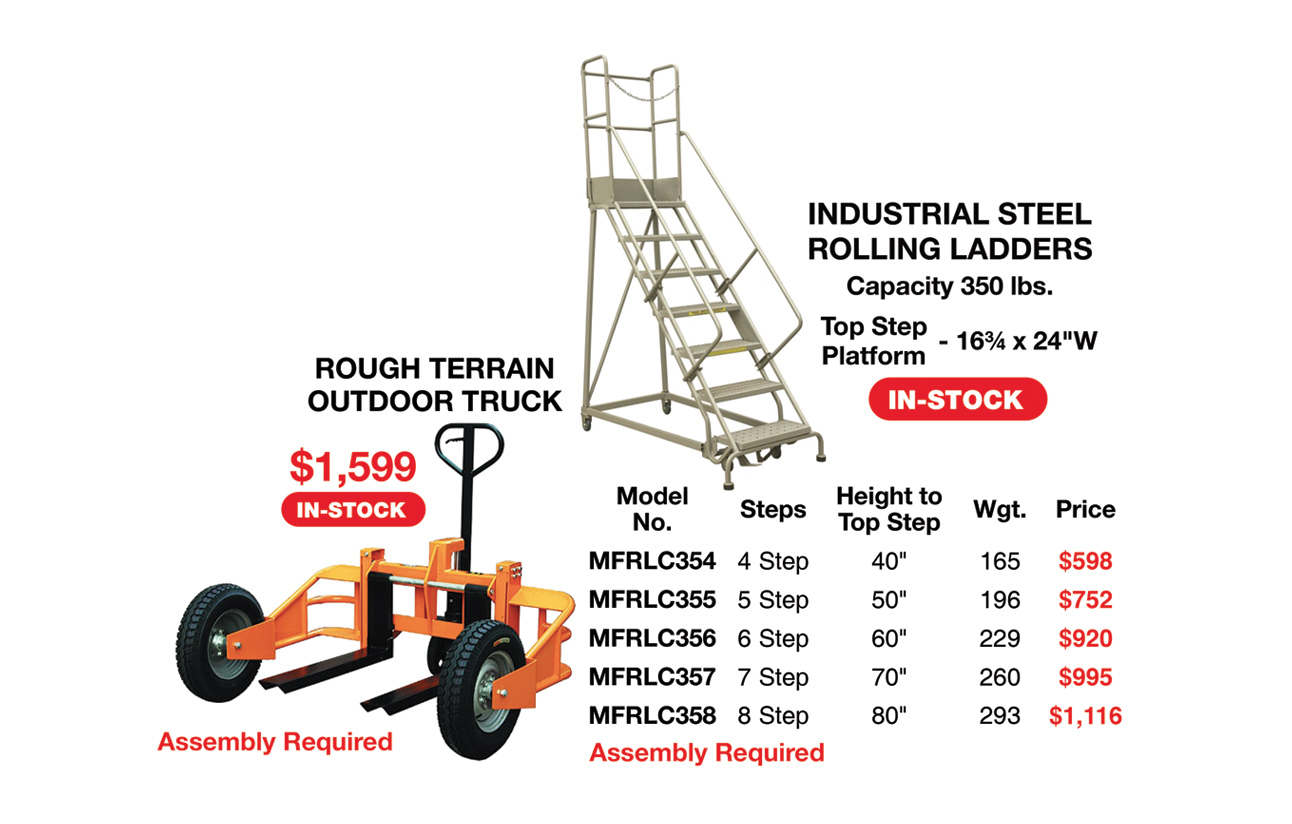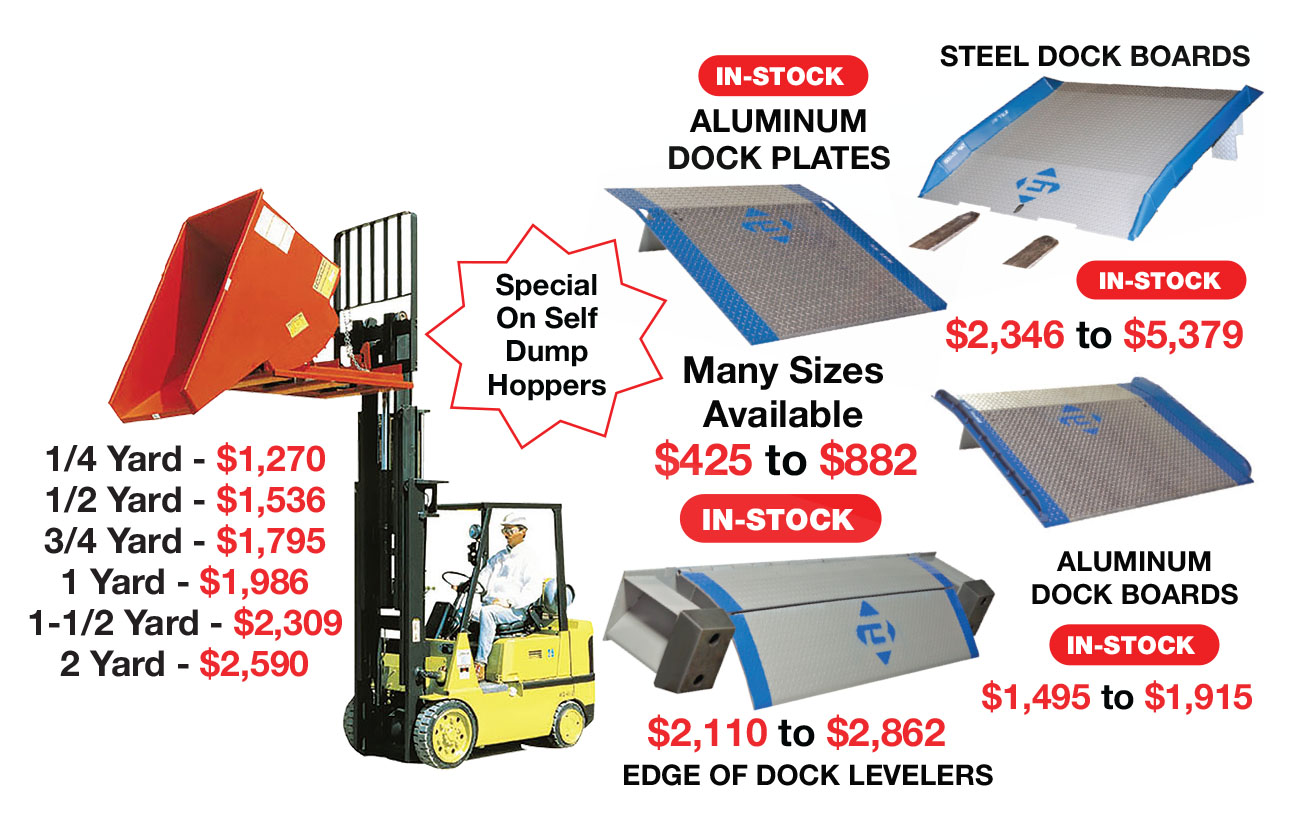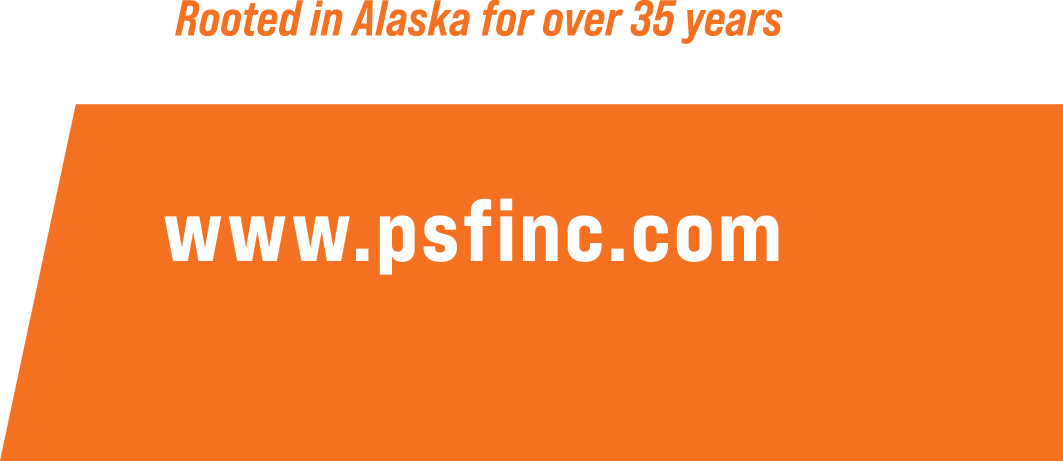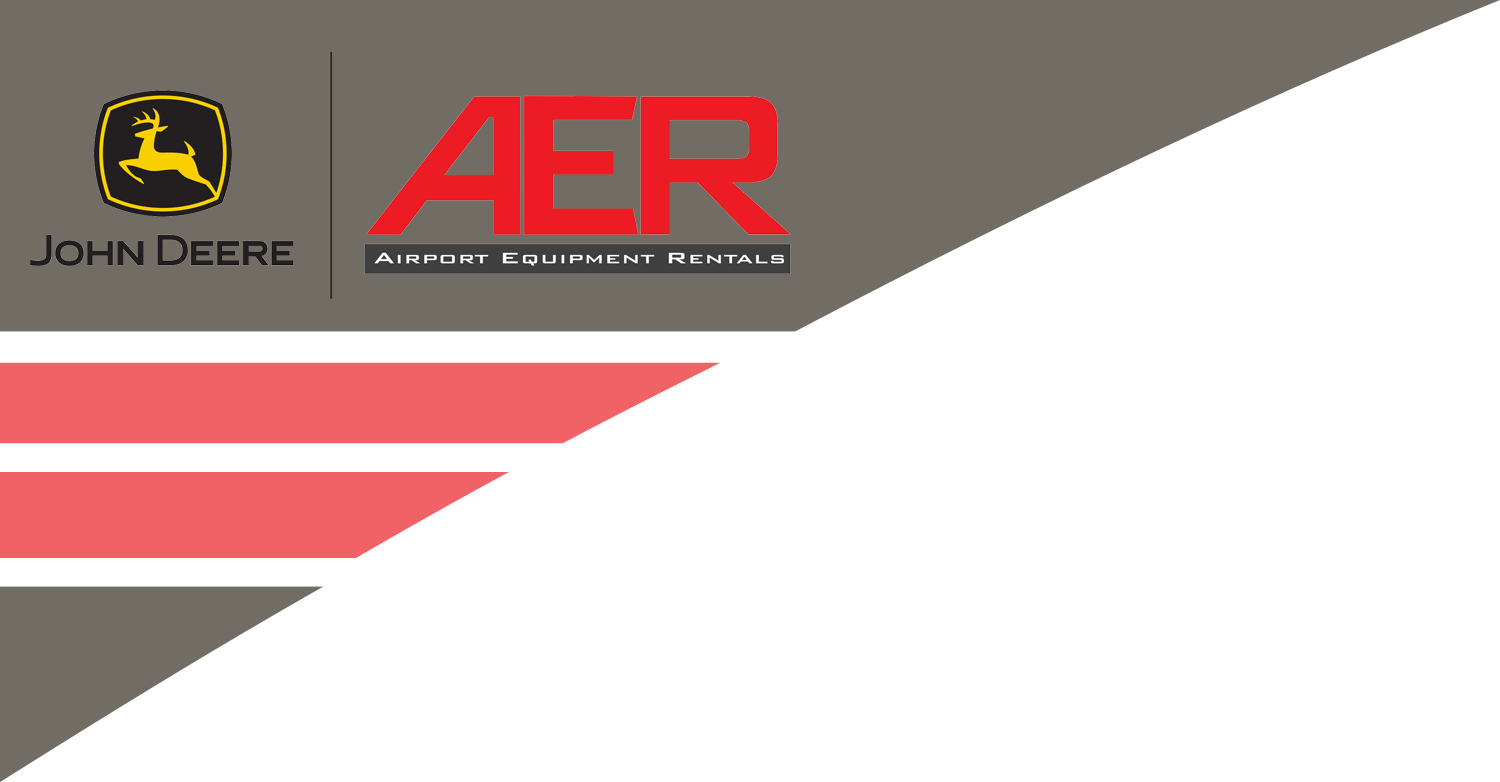
Our job is to keep you moving forward. Our machines are engineered with a “get it done” mentality and our After Sales Solutions are designed to keep you up and running.
The tougher your job gets, the easier it is to see we’re here when you need us most.
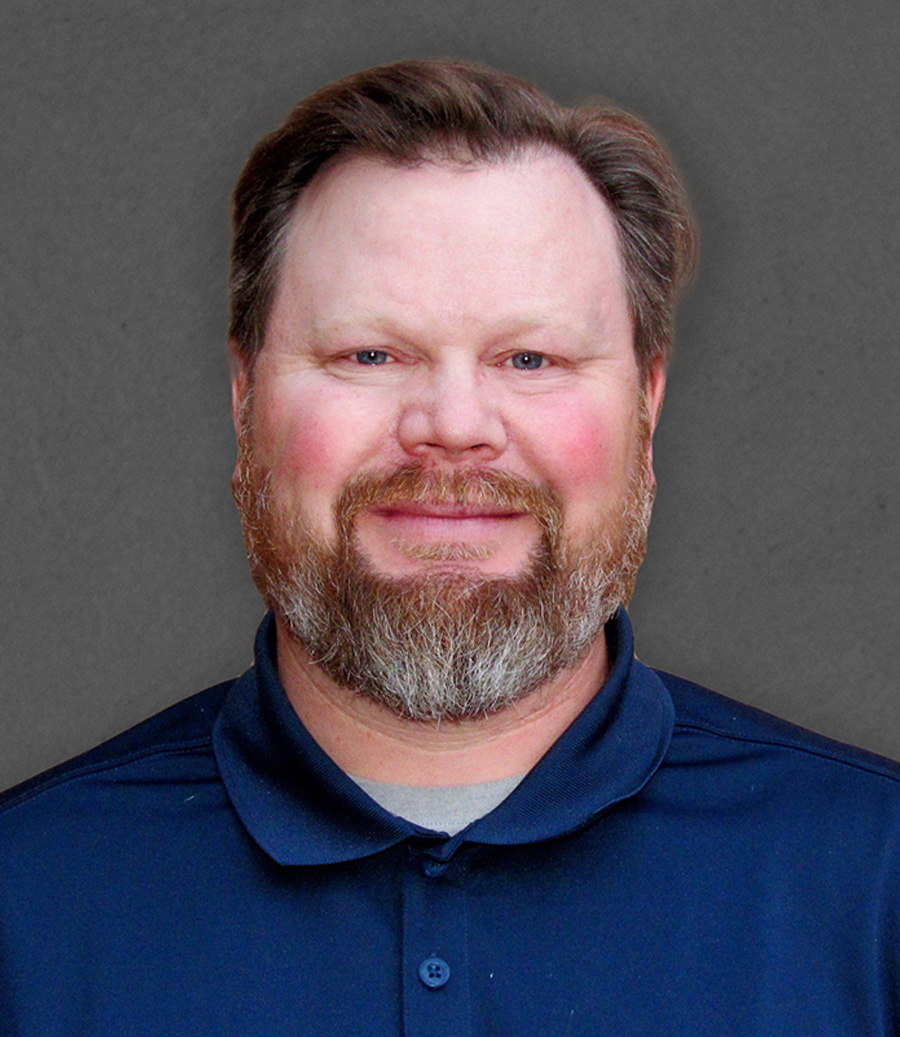
Fairbanks Branch
Mining Sales

Anchorage Branch
Sales Rep.
Hitachi, the best in construction equipment technology
IN ALASKA
CMI, the best sales and product support lineup
IN YOUR CORNER
The Winning Team
www.cmiak.com
Toll Free (800) 478-3822
Juneau, Alaska (907) 780-4030
Toll Free (888) 399-4030
Fairbanks, Alaska (907) 931-8808
Ketchikan, Alaska (907) 247-2228
Contents
Features
Streamlining the Waste Stream
Anchorage’s new central transfer station
Put on a Pretty Face
Anchorage’s Great Streets Façade Improvement Loan Program
Hardcore Metal
Phased research for strategic mineral production
Powder Reserve West
Eklutna, Inc. rescues Anchorage housing with Eagle River development
Hardcore Metal
Phased research for strategic mineral production
Streamlining the Waste Stream
Anchorage’s new central transfer station
Put on a Pretty Face
Anchorage’s Great Streets Façade Improvement Loan Program
Powder Reserve West
Eklutna, Inc. rescues Anchorage housing with Eagle River development
Quick Reads
From recruitment and training to promotion and graceful exits
When workplace culture clashes with cultural appropriation
Nancy Johnson sets the tone at KTUU
Patricia Morales | Alaska Business
Connecting military veterans to civilian jobs
Kimberly Koonce | DVIDS
Nancy Johnson sets the tone at KTUU
Patricia Morales | Alaska Business
From recruitment and training to promotion and graceful exits
When workplace culture clashes with cultural appropriation
Connecting military veterans to civilian jobs
Kimberly Koonce | DVIDS
About The Cover
The recipe to nourish and satisfy these tireless toilers: a spoonful of professional growth opportunities, a heaping helping of a healthy workplace, and a sweet glaze of enticing benefits. Sample the buffet within these pages. Bon appétit!

Partners to the Alaska Native Community
DWT has been part of the Alaska community for more than forty years. Our lawyers use their depth and breadth of experience to serve and partner with our clients, including many Alaska Native entities, as they develop, grow, and strengthen their non-profit and for-profit enterprises.
Business & Corporate
Energy
environmental
Government Contracts
Healthcare & Tribal Health Organizations
Labor & Employment
Litigation
Non-Profits & Foundations
Privacy & Security
Real Property
Telecommunications
From the Editor
Conversations around the holiday table led me to invite her to write for the magazine. Yes, Maija Doggett is that sister. She alerts me about HR issues I’ve never heard of, such as the problems with “tribe” in workplace jargon.
Respectfully, she’s not policing anybody’s language, especially not Native tribes or their members. But words contain codes that are not immediately obvious. For instance, my own article in this issue mentions the word “chief,” and a source outside the magazine advised caution, for reasons not unlike the trouble with “tribe.”

Billie Martin
press@akbizmag.com
Postmaster:
Send address changes to
Alaska Business
501 W. Northern Lights Blvd. #100
Anchorage, AK 99503
n several recent surveys and publications, it is well documented that business owners are searching for creative and unique staffing solutions. Examples include flexible work schedules, remote work, and job sharing, to name a few. In Alaska, this challenge is seasonally amplified. While employers grapple with staffing challenges, it’s important to recognize the significant benefit that temporary staffing offers to employers and employees alike.
Construction and maritime workers know this on-again and off-again “gig” all too well. Many look for a paying “gig” during winter to keep them busy and provide extra cash. Similarly, in the summer months, teachers work as tour operators. This is not a new concept, so why are employers continuing to hesitate to hire contingent staff based on “job hopping” or “being overqualified?”
indness is the beginning of philanthropy, but the formula for successful giving sometimes needs a catalyst. That’s when the Rasmuson Foundation, the largest private charitable funder in Alaska, steps in. The Rasmuson Foundation consistently finds the right time and place to donate that maximizes the effectiveness of its funding.
Chris Perez, Rasmuson Foundation’s vice president of programs, says the foundation actively seeks out projects that offer a chance to make positive change for the community they’re in—grants that help kids or improve a community’s health. Even better are those that do both, he says, citing the $400,000 that Rasmuson Foundation gave to Community Connections to help that nonprofit purchase two houses for therapeutic foster care, one on Prince of Wales Island and one in Ketchikan. “Catalytic support grants,” he calls them, referring to their ability to act as a catalyst or, according to Merriam-Webster, “an agent that provokes or speeds significant change or action.”
United Way
landlord
partner
than a roof and
four walls.
laska businesses are reaching for the sun with US Department of Agriculture (USDA) grants to take advantage of renewable energy or energy efficiency.
The Rural Energy for America Program (REAP) has $145 million to help agricultural producers and rural small business owners nationwide make energy efficiency improvements and renewable energy investments. Both grants are available to applicants in a one-year period, says Dan Smith, state energy coordinator for USDA Rural Development. The remaining periods for REAP applications in 2024 are April 1 to June 30 and July 1 to September 30.
n January, developers of the Bokan Mountain mining prospect on Prince of Wales Island acquired an 80,800-square-foot building to house an innovative process for separating rare earth elements. Unfortunately for the Lower Panhandle, the Strategic Metals Complex is not being built in Ketchikan, which was the plan less than two years ago.
Instead, Ucore Rare Metals acquired a disused facility at a former US Air Force base in Louisiana. The company expects to begin production there next year. A setback for Alaska’s mineral industry, but a step forward for domestic processing.
Currently, China produces more than 95 percent of the world’s rare earth elements.
ears of living with lymphedema inspired Laura Oden to go into business. Because of fluid buildup, her feet were two different sizes, so shoe shopping was a hassle. She wasn’t the only person in need of a solution, so Oden co-founded Pandere, a specialty shoe outlet for unique feet.
While Oden calls Alaska home, Pandere has a worldwide reach with a distributed team selling stylish footwear that can be adjusted to accommodate swollen feet. Technology ties the operation together.
laska Escape Rooms is an indoor adventure disguised by an innocuous storefront in downtown Anchorage. The rooms, plural, are named Raven’s Eye and Conjured Kingdoms. Each one-hour experience tells a story, inviting participants to solve puzzles and riddles and, in the process, choose whether to, say, imprison a villain or sacrifice themselves to rescue a damsel.
Since opening in 2017 on a wave of nationwide popularity for this new form of interactive entertainment, Alaska Escape Rooms has become a destination for date nights, bachelor and bachelorette parties, baby showers, and birthdays.
Its founder, Graeme Deishl, also wants customers to know that escape rooms are a business-to-business service. Companies can book time as team-building exercises. Indeed, Alaska Escape Rooms was recognized in 2018 in the Best Team Building Company category (since discontinued) of the Best of Alaska Business awards.
Let’s get
together
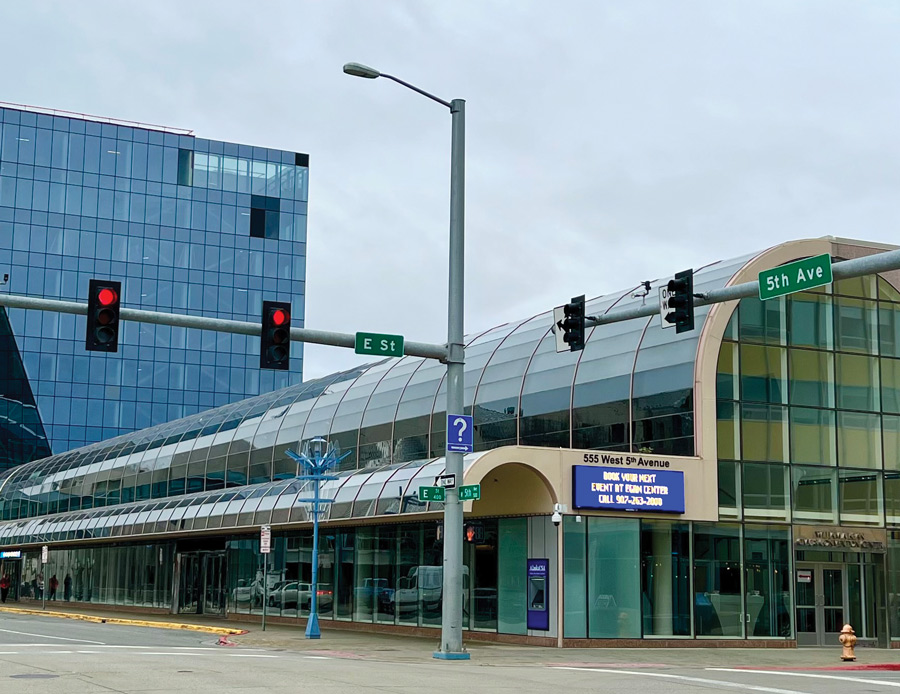

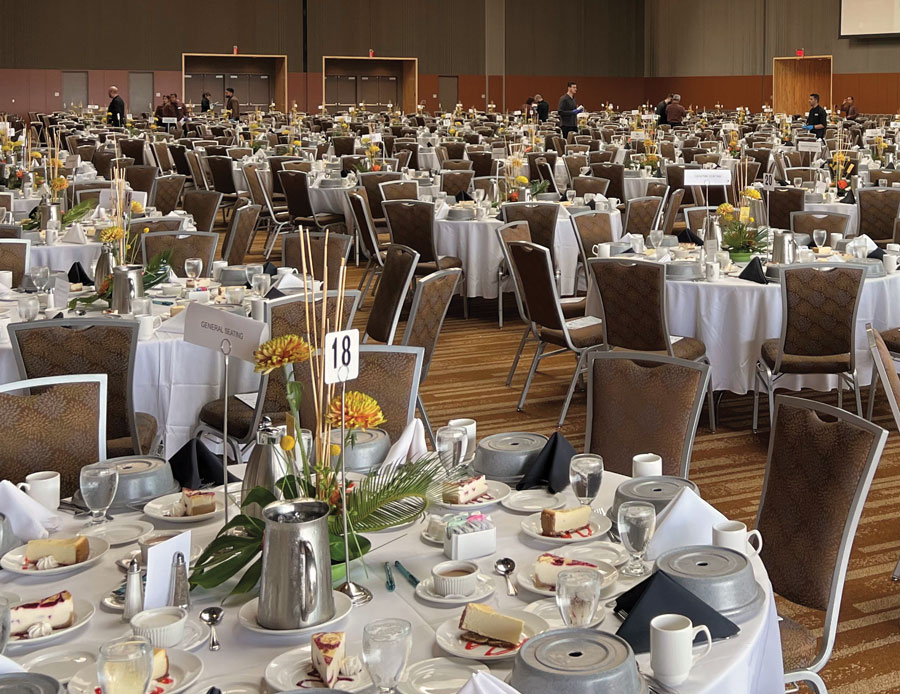
Events | Concerts | Conferences | Conventions | Banquets | Meetings | Trade Shows | Weddings | In-house Catering | Equipment Technology
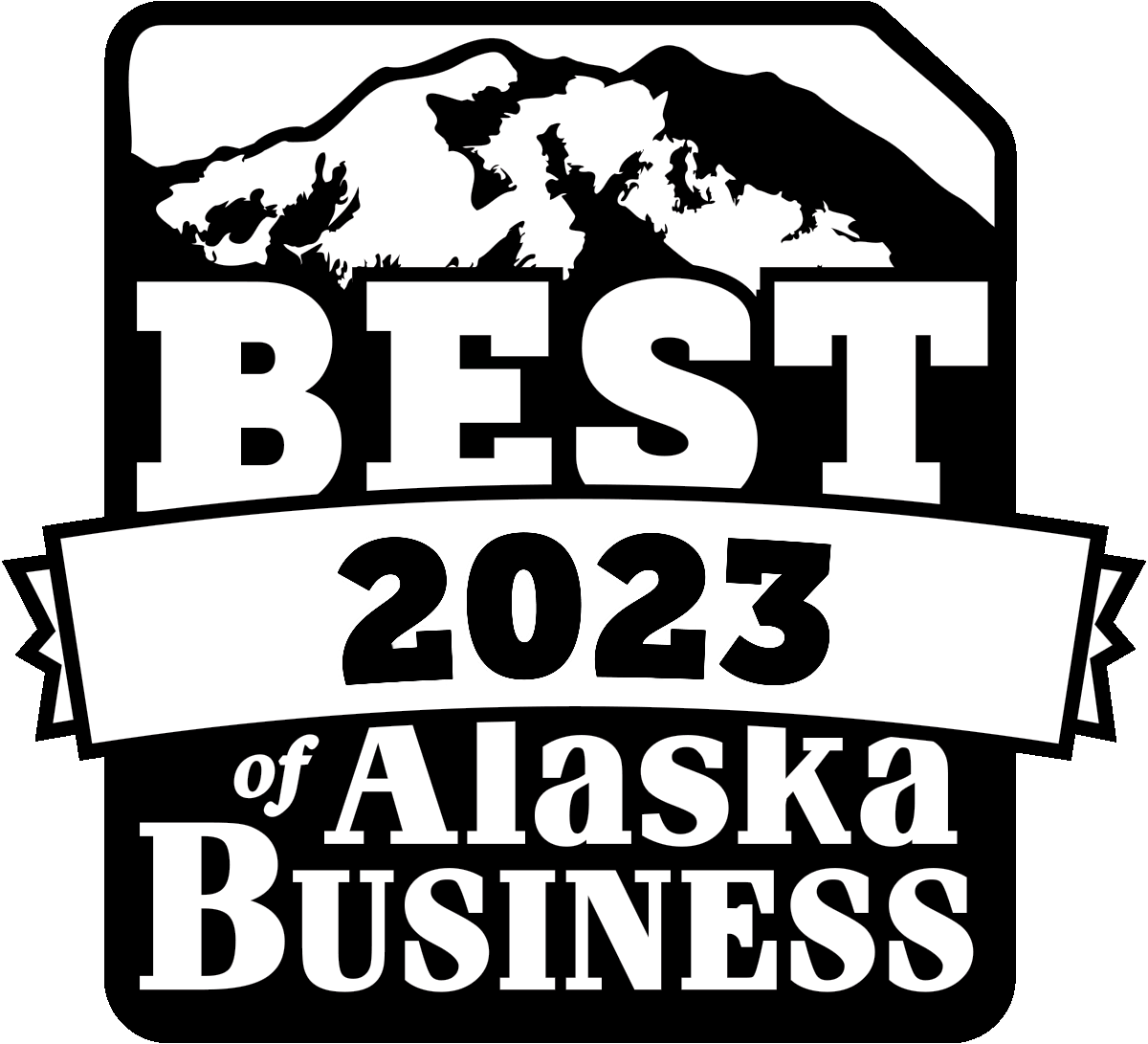


Northbound 800.426.0074 | Southbound 800.234.8683



Organizations invite themselves to this annual celebratory spread by virtue of their size—and by responding to a voluntary survey. Notice that five of last year’s top ten have pushed away from the table, plus many others, making room for twenty-two new place settings, ten of which have never appeared before. Consequently, all but three entries from last year’s list see their positions rising, like a fine dough.
Proper etiquette further dictates that listees maintain an Alaska address and business license. Thus, nonprofits and companies with Outside headquarters can qualify, but not the state’s largest public sector employers: the US Army, US Air Force, Anchorage School District, and the UA System.
In their company kitchens, the Corporate 100 blend wholesome ingredients with exquisite utensils to create the scrumptious ambrosia that keeps employees gratified and contented.
From Adak in the Aleutians to Juneau in the Southeast, to Elliott Highway in the Interior and in our hometown of Utqiaġvik, UIC is rising above to meet diverse business needs across Alaska.
And that’s just a tip of the iceberg.
n the vast expanse of Alaska, the interplay of extreme weather, brutal winter freezes, summer precipitation, and shifting climate patterns is profoundly affecting delicate tundra and coastal ecosystems. These environmental transformations not only have ecological repercussions but also striking implications for human communities. Alaska Native communities, residing in remote regions, find themselves increasingly vulnerable to these shifts. So what can be done to safeguard these lands and preserve cultural heritage in the face of such challenges?
The first step is having the scientific evidence to document and better understand the hazards these communities face. This enables communities to access needed resources and make appropriate decisions to address immediate and long-term threats. One critical piece of data is lidar mapping. Using advanced remote sensing laser technology, lidar is used to map surface features on the ground—such as signs of permafrost, floodplains, beaches, trees, and community infrastructure—to deliver high-resolution elevation models for precision analysis. These data can address multiple real-world challenges. Better flood modeling and erosion scenarios lead to improved disaster response and engineering strategies for mitigation.

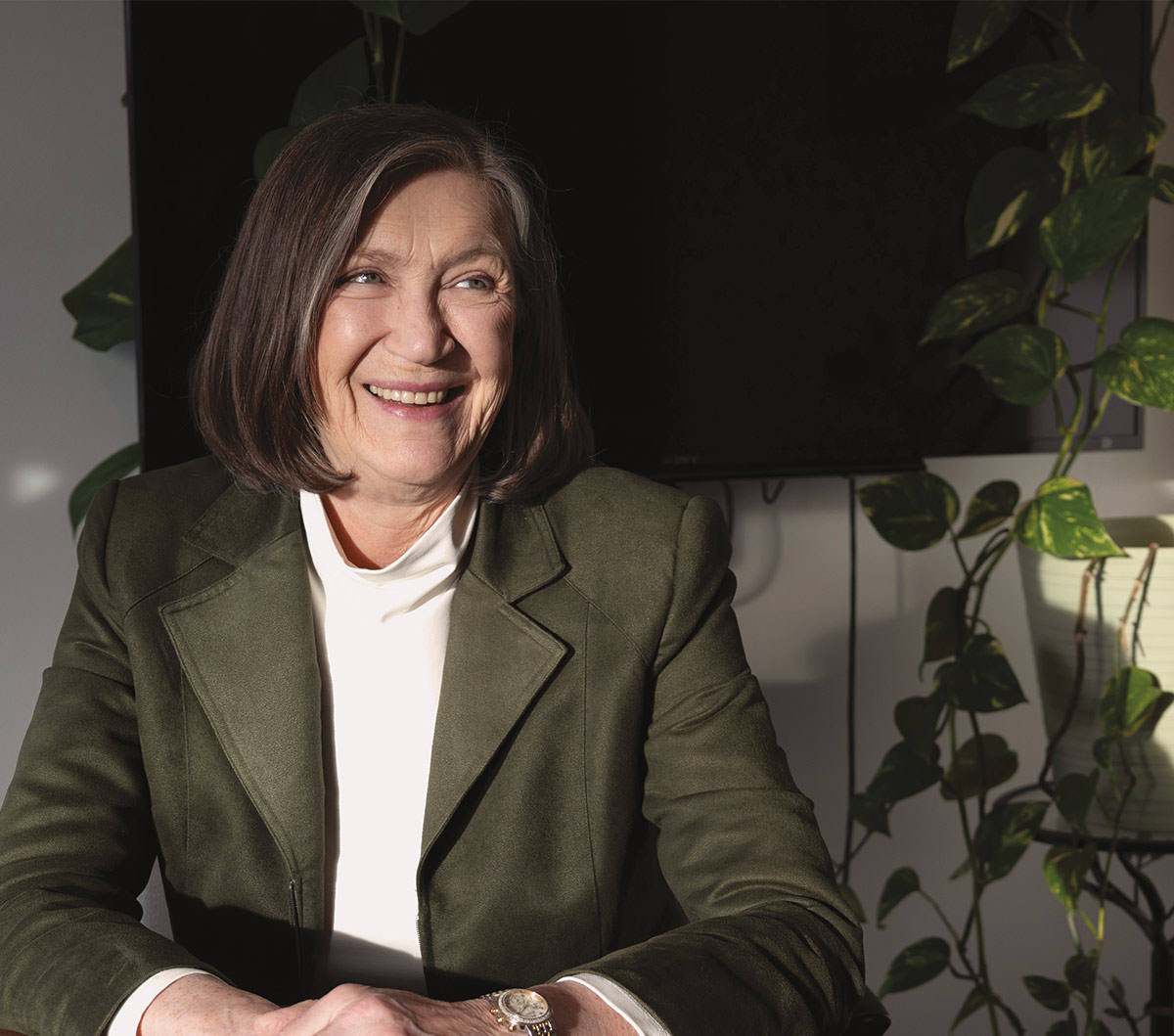
nside the master control room, Nancy Johnson watches monitors that flicker with the live feeds of Anchorage’s KTUU Channel 2 and KAUU Channel 5. As vice president of Gray Television and general manager of the local TV stations, Johnson prefers to sidestep the limelight and work behind the scenes. She has helped keep the NBC affiliate on the air since 1981, the year the former KENI-TV adopted its current call letters, making Johnson its longest employee—not to mention one of its most influential, even though she will rebuff this second descriptor.
“My successes aren’t my own,” she says, pointing to colleagues who assist with broadcast productions, news segments, and advertisement sales. Johnson classifies her efforts at KTUU as supporting and empowering others.
“I grew up on the East Coast. Work there was about who you knew and what you could get away with,” Johnson recalls. “Alaska wasn’t that way. Here, what mattered was your talents, how you’re contributing to the community.” This sense of belonging and feeling like she was making a difference motivated her to remain at KTUU.
ompanies in the Alaska Business Corporate 100 declare their top officer, the person who serves as the figurehead and the public face of the organization. These individuals hold a variety of titles, and some of them hold more than one title at a time.
On the 2024 list, the top officer for 21 percent of companies is a CEO. For 18 percent, it’s a president. One-quarter of the listings have some other title: vice president, senior vice president, executive vice president, general manager, district manager, operations manager, director of operations, owner, or some combination.
The most common single title, though, is a double title: president-slash-CEO, almost always in that order. Of the Corporate 100, 28 percent of companies have a top officer with this dual honorific.
umans are essential to the success of any business. Just as equipment, a working space, and financial capital are key components needed for an organization to “do” business, so are all the people who work and contribute to an organization. This includes employees and (increasingly in the gig economy) independent/temporary and on-call and workers employed without a traditional labor contract. Human resource (HR) professionals are tasked with creating the environment for individuals and teams to achieve better performance for an organization, and these efforts can happen before, during, or post-employment.
Changes in the HR field had previously been incremental, but in recent years they have been revolutionary. The HR field has changed more in the last three years than in the previous fifty. According to the Society for Human Resource Management (SHRM):
The COVID-19 pandemic threw employers and employees into chaos and uncertainty, with no clear end in sight. HR operated in crisis mode for much of 2020 and the first half of 2021, figuring out how employees could work from home, trying to provide extra mental and physical health support, and working more than ever on C-level strategies for keeping their organizations functioning. As the dust continues to settle and companies adjust to a new normal, the role of HR has fundamentally changed.
The COVID-19 years accelerated work-technology, adapting to the need for remote work. Along the way, many long-held corporate rules about leave, work travel, layoffs, and overtime policies were drastically changed.
xcited as my former colleagues were for my new adventure when I changed jobs in 2023, they were also sad to see me go. At twenty-plus years of service, I had the longest tenure of all employees in the human resources department. Many of my coworkers expressed how much they were going to miss my “tribal” knowledge of the firm’s HR practices.
It wasn’t a tribal entity that I worked for. I’m not of American Indian or Alaska Native descent, and I don’t belong to any of the 574 tribes recognized by the US government. When my coworkers referred to my “tribal” knowledge, what they meant was my institutional knowledge of the firm’s history, employee policy development, and corporate culture, which many of my teammates found to be useful in doing their own jobs. They were using “tribal” in the context of referring to our workplace as our tribe.

Trust in Cook Inlet Tug & Barge.

ife is a college. When evaluating potential employees, many companies are looking beyond higher education or a résumé loaded with relevant work experience to notice a subtler sort of qualifications. Applicants may have nontraditional backgrounds that translate into excellent job performance. This expansive view might not have been obvious until relatively recently, when hiring became a headache.
Faced with difficulty finding qualified workers, Governor Mike Dunleavy issued an administrative order in February 2023 that waived the college degree requirement for most State of Alaska jobs. Dunleavy said, “Today people can gain knowledge, skills, and abilities through on-the-job experience. If we are going to address our labor shortage, we must recognize the value that apprenticeships, on-the-job training, military training, trade schools, and other experiences provide applicants. If a person can do the job, we should not be holding anyone back just because they don’t have a degree.”


Anchorage, AK 99501-5907


The Meeting:
District 12 Annual Meeting
May 4-7, 2023
350 Delegates
Estimated Economic Impact:
$218,114
Nathaniel Rivers,
Meeting Champion

The Meeting:
District 12 Annual Meeting
May 4-7, 2023
350 Delegates
Estimated Economic Impact:
$218,114
The men of Omega Psi Phi Fraternity embody four cardinal principles: manhood, scholarship, perseverance, and uplift. Alaskan Nathaniel Rivers exemplified those principles, spending 30 years in the Army, three seasons in the NFL, and as a full-time mentor and volunteer in Anchorage. Inspired to reconnect past and present brothers of Omega Psi Phi, Rivers set his sights on bringing his fraternity’s annual meeting to Anchorage. Making his case to host, Rivers successfully landed the bid and the group held their district meeting in Anchorage for the first time since 1998. Inspired by the allure of Alaska, 350 attendees came from across the country to enjoy Anchorage’s urban and outdoor experiences. Anchorage proved the perfect fit for these Omega Psi Phi brothers, weaving an unforgettable story into the fabric of their fraternity.
Are you a member of an association?
Contact Visit Anchorage to bring your group to town:
meetings@anchorage.net | 907.276.4118
ife in uniform doesn’t always translate into relevant civilian work experience after military personnel finish their tours of duty. Fortunately, several programs and resources can help prepare for life after leaving the service.
“Not to be flip, but whether a person has served a few years or a lifetime in the military, it’s like being a teabag in water,” says Mary M. Rydesky, a professional coach who works with the federally funded Transition Assistance Program (TAP). “They’ve been imbued in the culture, and their whole identity is shaped by the expectations of the military and the community that supports them.”
Differences include some fundamental aspects that most workers take for granted. “While a civilian workplace culture is 8-to-5, in the military, the culture is 24-7,” Rydesky says. “Military personnel are brought up with expectations about the workplace, values, and performance.”
lectrical systems rarely receive the same attention as the showier parts of engineering. Not only are wires hidden within walls, but the current they carry, unlike water in pipes, is invisible. It’s easy to think of electrical designs in terms of lights and outlets; however, the field has grown to encompass advancing technologies used for safety, productivity, and a healthier environment.
Anchorage, AK 99507
www.materialflow.com
n Anchorage, solid waste ends up at the regional landfill off Hiland Road. This includes ash and grit from the wastewater treatment plant as well as industrial and household refuse. Rather than drive to Eagle River, though, commercial haulers and individuals have the option of dumping in Midtown.
The city-owned Solid Waste Services (SWS) maintains a Central Transfer Station off Old Seward Highway, between International Airport Road and Dowling Road. The exact address flipped to the other side of East 56th Avenue last fall with the completion of a replacement facility. Opened September 8, 2023, the Central Transfer Station is expected to extend the life of the Anchorage Regional Landfill from approximately 2065 until 2085.

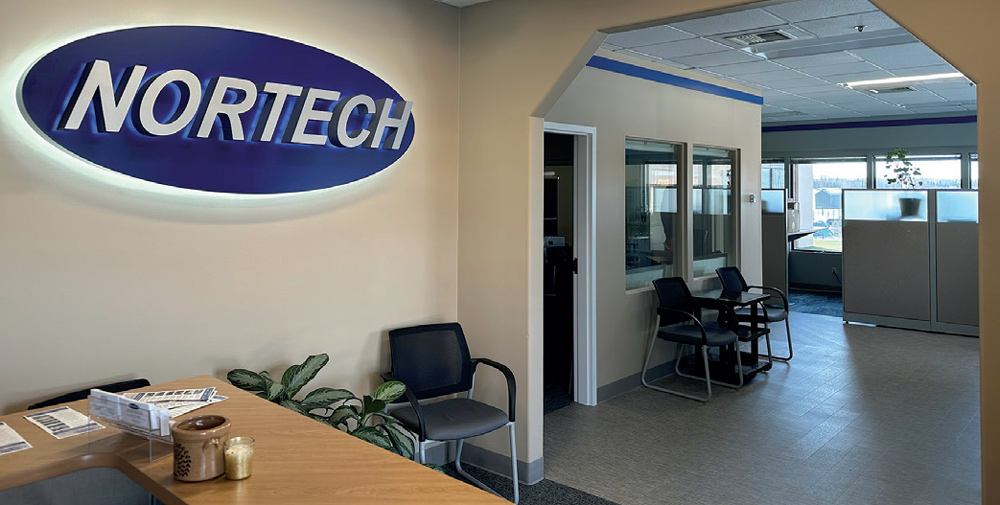
or NORTECH, Inc., the phrase “Engineering Solutions to Keep Alaska Beautiful and Alaskans Safe” is more than just a slogan. This embodies the essence of the value the firm generates throughout the state. NORTECH, Inc. provides environmental engineering, industrial hygiene, and hazardous materials management solutions that help organizations maintain functional, safe, and healthy conditions.
NORTECH, Inc. has been serving public- and privatesector clients since 1979, when it was originally founded by John Hargesheimer, PE, CIH, currently a senior consultant. Led today by Peter Beardsley, PE, and Jason Ginter, PMP, the company has offices in Fairbanks, Juneau, and Anchorage and a multidisciplinary staff fulfilling its mission: “providing the highest-quality environmental engineering and industrial hygiene solutions.”
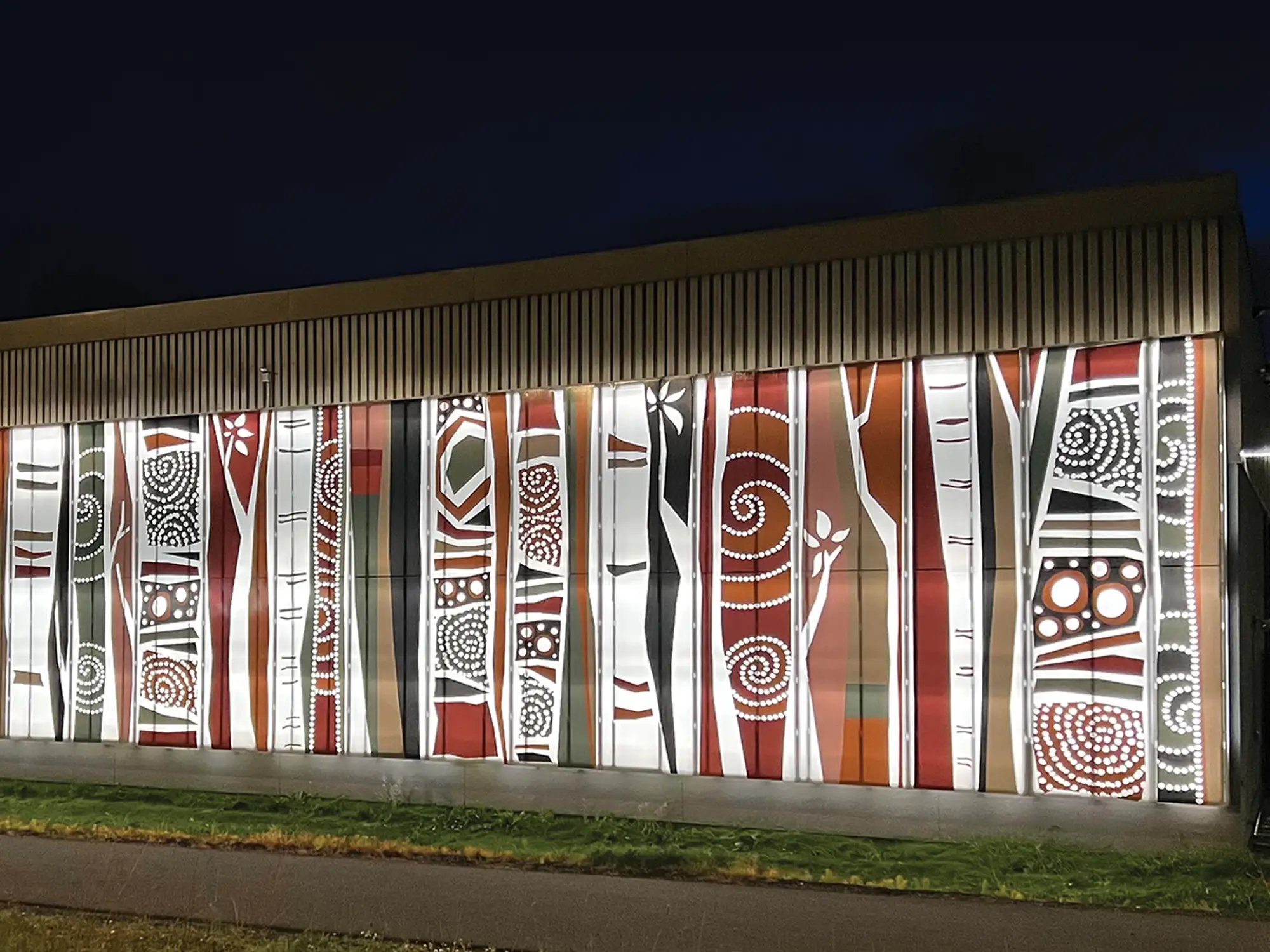
Anchorage Community Development Authority
ecret shoppers scouted Anchorage in the winter and summer of 2022. Posing as tourists or prospective residents, they evaluated the city for its attractions, amenities, ease of movement, and customer service.
Arizona-based consulting firm Roger Brooks International compiled the findings as the Anchorage Destination Assessment. The clandestine visitors had plenty of suggestions for improvement. The report included recommendations for better signage, more logical traffic patterns, and general municipal beautification.
To implement the recommendations, Mayor Dave Bronson empaneled the Project Anchorage Task Force. The group assigned priorities to changes that could be made right away. One of those low-hanging fruits is the Great Streets Façade Improvement Loan Program, now concluding its first year.
West
Eklutna, Inc.
efore Anchorage was a city, the Dena’ina Athabascan people called the area home. One of their eight local villages was Idlughet, situated near the glacier-fed Idluytnu river. Today, both the village and the river are named Eklutna.
The city grew up around the Eklutna people’s fish camps and hunting grounds. The unification of the Greater Anchorage Area Borough into a single municipality in 1975 tied the Eklutna village even closer to the city, one more link in a chain of suburbs along the Glenn Highway through Eagle River and Chugiak.
A freeway interchange built near Fire Lake in the ‘90s surmounted the highway as a barrier to westward development. While a Fred Meyer supermarket opened at one side of the interchange, a residential subdivision sprouted across the highway, off a feeder street called Eklutna Park Drive. At the end of the street, the Eklutna village corporation, Eklutna, Inc., operates a gravel pit, just one of the many commercial ventures by Eklutna, Inc. as the largest landowner in Anchorage.
Among the village corporation’s more than 100,000 acres is undeveloped land on the opposite side of Eklutna Park Drive. The wooded tract overlooking Lower Fire Lake backs onto a subdivision near Chugiak High School. Eklutna has its eye on turning the property into the newest bedroom community in Eagle River.
don’t think I’m going out on a limb when I say print is here to stay. I’ll admit that I may be a little biased because I am fortunate to work for the best B2B print publication in Alaska. Some of you may be reading this in our exceptional digital edition (digital.akbizmag.com), but many of you are holding our physical, print magazine in your hands to browse this issue.
Combining print magazine advertising with digital options is powerful, and research shows it. Alaska Business continues to evolve, offering creative ways for clients to target their message through a combination of print advertising, responsive digital ads, Spotlight Digital Profiles (akbizmag.com/spotlights/), the weekly Monitor, (digital.akbizmag.com/media-kit-2024/#newsletters) and Industry (akbizmag.com/industry/) banner ads on our website. We also have live event sponsorship opportunities and use social media to connect our readers with us, other businesses, and with you.
pting to replace the old with the new can profoundly impact the community’s fabric. So it is with Kodiak, one of Alaska’s oldest cities, and a new shopping center. The transformation is driven by Kodiak Area Native Association (KANA), which is mainly responsible for healthcare on the archipelago. Through the new Kodiak Marketplace, KANA took a big leap into commercial real estate, a venture that is energizing the whole community through strategic redevelopment.
The structure that would become the Kodiak Marketplace was originally built after the 1964 earthquake as a Kraft Foods store. This development was significant for Kodiak, often likened by elders to “big city” advancements.
In the late ‘70s, Alaska Commercial Company acquired and remodeled the building, operating it until a decade ago. This location provided essential grocery and food security and introduced significant advancements to the community, including a Burger King franchise that marked a notable evolution in the community’s commercial landscape.
esources are limited for Occupational Safety and Health Administration (OSHA) enforcement, so the agency has implemented National Emphasis Programs (NEPs) as a temporary focus on particular hazards and high-hazard industries. Existing and potential NEPs are evaluated using inspection data, injury and illness data, National Institute for Occupational Safety and Health reports, peer-reviewed literature, analysis of inspection findings, and other available information sources.
At a more granular level, Local Emphasis Programs (LEPs) are enforcement strategies designed and implemented at the regional office and/or area office levels. These programs are intended to address hazards or industries that pose a particular risk to workers in that office’s jurisdiction. The emphasis programs may be implemented by a single area office or at the regional level (Regional Emphasis Programs) and applied to all area offices within the region. These LEPs are accompanied by outreach intended to make employers in the area aware of the program as well as the hazards that the programs are designed to reduce or eliminate. This outreach may be in the form of informational mailings, training at local trade shows, or speeches at meetings of industry groups or labor organizations.

Alaska Trends
early fifty years ago, the Alaska Energy Authority (AEA) was established as an independent public corporation, tasked by the state government with supporting the development of energy projects. AEA gained a new tool in 2008, when the Alaska legislature created the Renewable Energy Fund (REF) and the associated Renewable Energy Grant Recommendation Program.
A temporary program at first, REF’s five-year sunset date was extended in 2012 and then, last year, repealed entirely, cementing the program as a permanent component of Alaska’s energy infrastructure toolkit.
With its future now boundless, AEA looked back on REF’s past. The authority commissioned BW Research Partnership to examine the program’s economic, community, and environmental impacts. Some of those results are discussed in this month’s article “Energizing Renewables” by Dimitra Lavrakas, along with other public financing that helps Alaskans plug into solar power or other sustainable sources.
A Thousand Trails Home: Living with Caribou by Seth Kantner.
What charity or cause are you passionate about?
My wife and I are really focused on supporting kids at risk. We’re both really attuned to and close to Covenant House and Clare House.
What’s the first thing you do when you get home after a long day at work?
[He laughs] We usually walk the dog. We have a cockapoo, Phoebe.
What vacation spot is on your bucket list?
The Lodge at St. Edward State Park [a hiking spot just north of Seattle].
If you could domesticate a wild animal, what animal would it be?
I don’t know. Maybe a wolf.

A Thousand Trails Home: Living with Caribou by Seth Kantner.
What charity or cause are you passionate about?
My wife and I are really focused on supporting kids at risk. We’re both really attuned to and close to Covenant House and Clare House.
What’s the first thing you do when you get home after a long day at work?
[He laughs] We usually walk the dog. We have a cockapoo, Phoebe.
What vacation spot is on your bucket list?
The Lodge at St. Edward State Park [a hiking spot just north of Seattle].
If you could domesticate a wild animal, what animal would it be?
I don’t know. Maybe a wolf.
Off the Cuff
pstairs at the Anchorage Museum, the Arctic Studies Center is the Smithsonian Institution’s toehold in Alaska. Inside its Gillam Archaeology Laboratory and Art Space, center director Aron Crowell prepares for a visitor by laying out artifacts he and his teams collected in Yakutat, Klukwan, and Kodiak: a cooking pot, projectile points, a Russian musket ball.
The visitor is Rob Gillam. His name is on the wall as part of the Robert B. Gillam family, the lab’s primary benefactor in 2010 when the museum expanded. Gillam, the CEO of financial services firm McKinley Management, sustains the family’s work at the museum.
- Construction Machinery Industrial
- T. Rowe Price
- First National Bank Alaska
- Davis Wright Tremaine Llp
- PeopleAK
- United Way of Anchorage
- American Heart Association
- Denali Commercial
- Junior Achievement
- Alaska Pacific University
- R & M Consultants Inc.
- Northrim Bank
- Donlin Gold
- Oxford Assaying & Refining Inc
- JENNMAR
- Chugach Alaska Corporation
- Structured Communication Systems
- Umialik Insurance Company
- Anchorage Convention Centers
- Design Alaska
- TOTE Maritime Alaska LLC
- Global Credit Union
- Providence Health & Services Alaska
- GCI
- Matson Inc.
- Denali Universal Services
- The Odom Corporation
- Ukpeagvik Inupiat Corporation
- Cruz Companies
- Hotel Captain Cook
- Petro Marine Services
- Beacon Occupational Health & Safety Services
- Sourdough Express, Inc.
- NV5 Geospatial
- Toast of the Town
- JAG Alaska
- Wrightway Auto Carriers, Inc.
- Southcentral Foundation
- Alaska Mergers & Acquisitions, LLC
- ASTAC - Arctic Slope Telephone Assoc
- Landye Bennett Blumstein LLP
- PND Engineers Inc.
- Lane Powell
- Subway of Alaska
- Alaska APEX Accelerator
- Cook Inlet Tug & Barge Inc
- Dorsey & Whitney LLP
- Visit Anchorage
- Nana Regional Corp
- PIP Marketing Signs Print
- 3-Tier Alaska
- Conrad-Houston Insurance Agency
- Davis Constructors & Engineers Inc
- Material Flow & Conveyor Systems, Inc.
- Resolve Marine
- Nenana Heating Services, Inc
- Samson Tug & Barge
- Nortech Environmental & Engineering
- Span Alaska Transportation LLC
- State of Alaska Department of Health
- Doyon, Limited
- Tongass Federal Credit Union
- Seatac Marine
- Stellar Designs Inc
- Westmark Hotels - HAP Alaska
- Parker, Smith & Feek
- Northern Air Cargo
- Airport Equipment Rentals
- Lynden

460E Mud Truck
– Traction Boosting Auto Diff Locks
– Jobsite Adaptive Suspension
– Smooth, Optimized, Fast Cycle Shifting
Backed by a Industry Leading
5-Year / 15,000 Hour Transmission Warranty

460E Mud Truck
– Traction Boosting Auto Diff Locks
– Jobsite Adaptive Suspension
– Smooth, Optimized, Fast Cycle Shifting
Backed by a Industry Leading
5-Year / 15,000 Hour Transmission Warranty

907.659.2000
907.456.2000
907.522.6466
907.474.2000
Anchorage
907.522.6466
Delta Junction
907.895.9898
Fairbanks
907.456.2000
Prudhoe Bay
907.659.2000
The Rental Zone
907.474.2000
Kenai
907.335.5466
Dynamic Routing!
